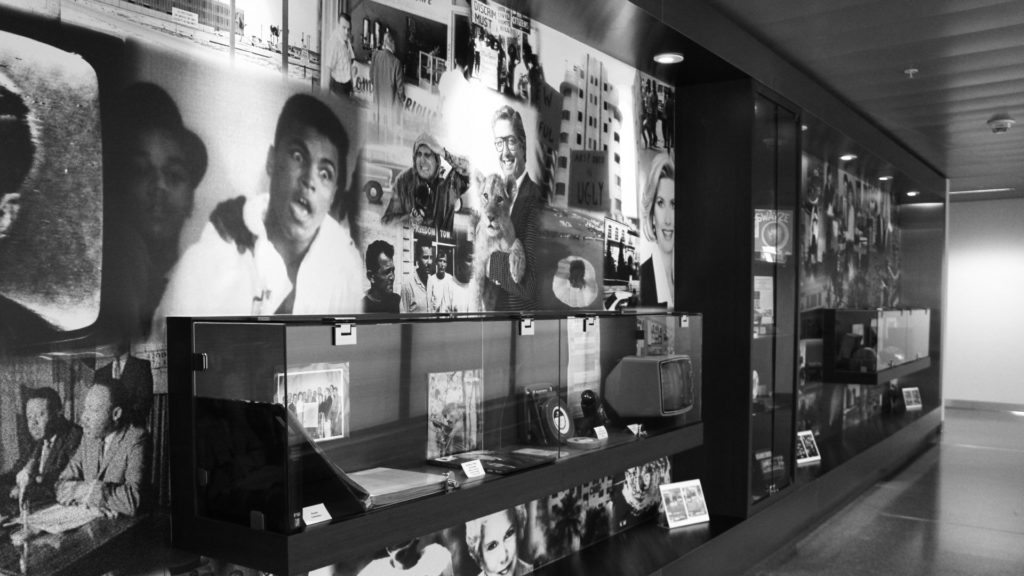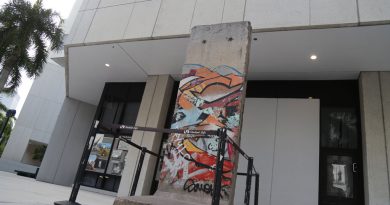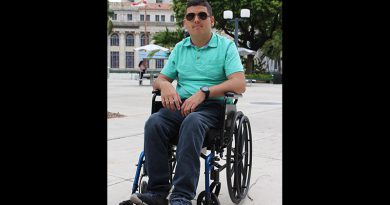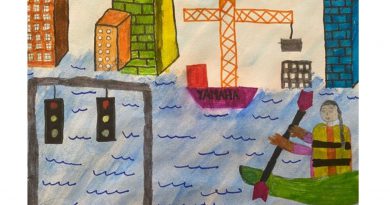Archives Preserves History Of Miami On Film
The Lynn and Louis Wolfson II Florida Moving Image Archives, located on the fourth floor of building 8000 at Wolfson Campus, captures iconic moments in Miami history.
Newsreels show Jim Morrison taking a drag of a cigarette in the hallway of a Miami courthouse, Martin Luther King Jr. telling a crowded church in Overtown about the fight for voting rights and screaming teenagers surrounding the Miami International Airport observation platform as The Beatles take their first steps on Miamian soil.
“Educating yourself about history, and particularly about the place where you live, is important to being a good citizen,” said Rene Ramos, the Archives’ director. “But it’s also important just to surviving because you understand why things are the way that they are. They’re the way that they are because of what happened before.”
Ramos and the Archives’ staff make materials available to students working on documentaries, projects and/or reports. He believes that the Archives is significant because it allows students and locals to better understand the place where they live and go to school. Within its walls are more than 35,000 hours of videotape and 23 million feet of film dating as far back as the early 1900s. If all of the film was combined into a single reel, it would span the distance from Miami to Los Angeles twice.

Reeling It In: Amy San Pedro, an archives assistant, cleans film before it undergoes the digitizing process. The Lynn and Louis Wolfson II Florida Moving Image Archives is located on the fourth floor of building 8 at the MDC Wolfson Campus.
A family of cultural pioneers, benefactors and politicians, Lynn and her husband, Louis Wolfson II, were the main benefactors spearheading the Archives’ development in its earliest stages. Louis’ younger brother, Mitchell Wolfson Jr., founded the Wolfsonian at Florida International International University in 1986. It was also formed in part by local historian Arva Moore Parks and WTVJ’s first and longest running news anchor, Ralph Renick. The collection was founded in 1984 by the Miami-Dade Public Library System, Miami Dade College and the University of Miami. It has been housed at MDC since 2009.
Historian and MDC history professor Paul George describes the Archives as a “treasure trove” of television news footage, documentaries and home movies. George regularly takes his classes to the Archives for screenings as a way of enhancing the curriculum of his History Of South Florida course.
“It’s a wonderful alternative way to learn history through historical and documentary videos.To learn it visually,” George said. “The students we have today are heavily visual learners and this is the perfect approach. So many people could be served so well by it.”
Jordan Llanes, 19, a finance major and a student of George’s History of South Florida course, said having access to the Archives is like having access to a time machine.
“Everything you need to know about South Florida history is on the fourth floor of building 8. [The Archives] makes learning history a really enjoyable experience,” Llanes said.
However, not all of South Florida’s history is enjoyable. Many commuters complain about unfinished and cluttered highways and lack of developed public transportation. The Archives can answer many questions about how our thoroughfares became tangled.
“The way that you find out is by digging into the history, and that’s what you can do with an archive,” Ramos said.
The staff at the Archives are digitizing the collection to make information easily and readily accessible to the public. The videotape/cassette collection is already 95 percent complete. The process of digitizing 23 million feet of film is time consuming and tedious because the Archives’ digitizing equipment for film only reads one canister at a time. Also, the companies that provide the equipment are no longer producing the machines that make the entire digitization process possible. But Ramos believes completing the momentous task is ultimately worth it.
“[The film] is some of the most interesting stuff because it’s a lot of home movies and stuff from the 1940s and 1950s,” Ramos said. “It’s a real window into that era.”

Tons Of Tapes: The Archives has a collection of television news, documentaries and home movies that are digitized and available to the public.
The Archives also serves as a completely free resource for artists, journalists and members of the public. Accessing the clips for personal or academic use is a simple process. Students can do quick searches on the Archives’ website, which already hosts more than 60,000 clips, or sift through the thousands of clips hosted on their Youtube channel. If a viewer sees something of interest that is not digitized, they need only email the Archives’ staff who will make it available to them either through a Dropbox or CD. If a particular clip isn’t digitized yet, the staff will still retrieve it from the collection and screen it on their projectors for students to watch and take notes.
The Archives regularly hosts events to allow students and public to engage with the collection, like their weekly Rewind Screening Series, which takes place every Tuesday and Thursday in Room 8401 from 12 p.m. to 1:30 p.m. The screenings are free and open to the public. Past showings have included South Florida Nights, a series of news stories highlighting bars and nightclubs of the Miami Vice Era and Segregated Miami, newsfilm which records life in Miami’s African American communities during racial segregation.
The Archives will also host former WTVJ television news journalist Diana Gonzalez for a program called Ticket To Havana, on Oct. 20 at 7 p.m. in Room 7128. It features tales of her 1979 reporting trip in the Cuban capital city. The footage is unique because it was taken just months before the Mariel Boatlift, which brought more than 100,000 Cubans seeking asylum to the United States, and ended U.S. travel to the island country.
Public programs coordinator at the Archives, Kevin B. Wynn, is responsible for curating and editing all of the weekly Rewind Screenings and also partners with several local cultural institutions to share the collection with the community in fun and engaging ways. Most recently, during Miami Swim Week, the Archives partnered with The New Tropic and the Freehand to highlight swimsuit styles from the 1950s to the 1980s.
Ultimately, the Archives wants the community to realize that in this day and age, we are all creators of media.
“What we’re trying to do is educate people about and what we’re doing. You are the steward of a collection, just like we are. You are archivists, or you can be, or you should be,” Ramos said. “If nothing else, just make sure you are a good guardian of the information that you are creating and that’s important to you.”




